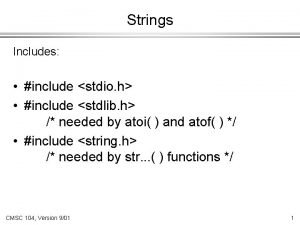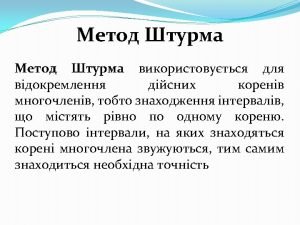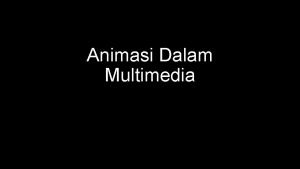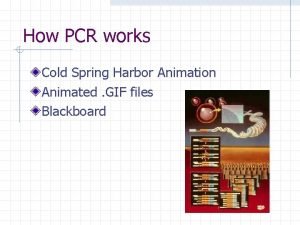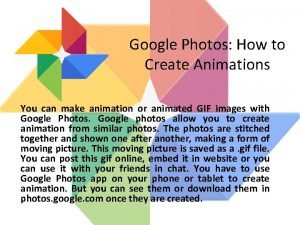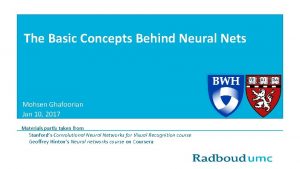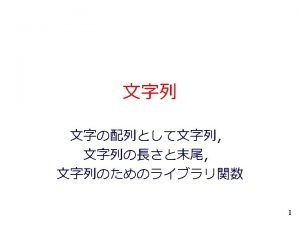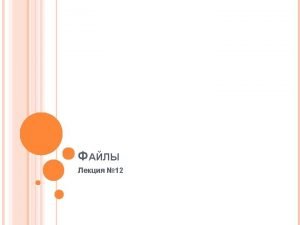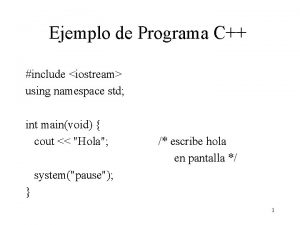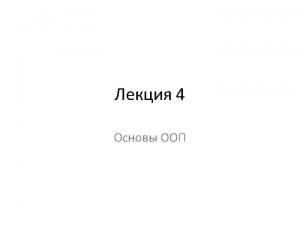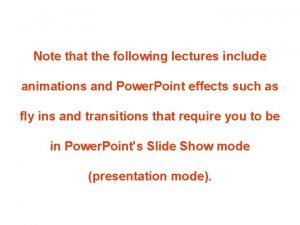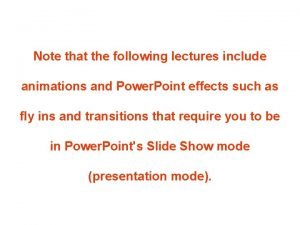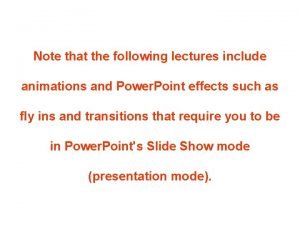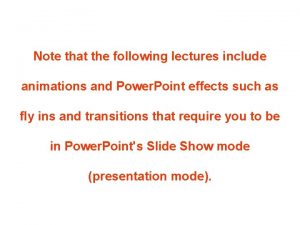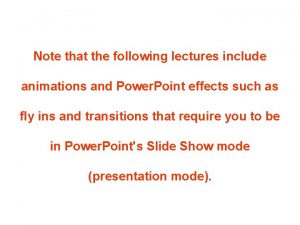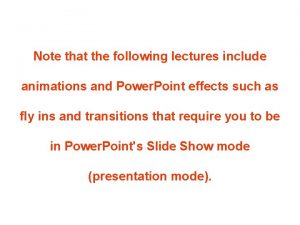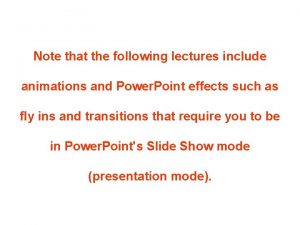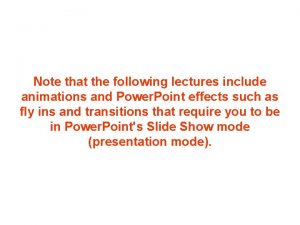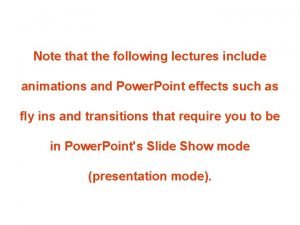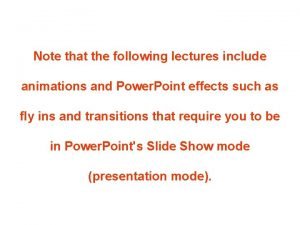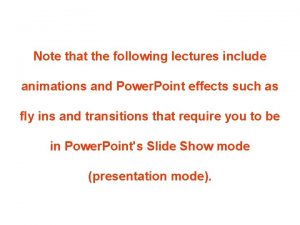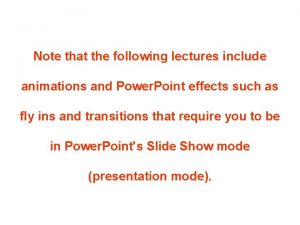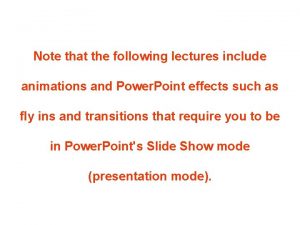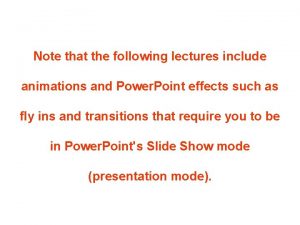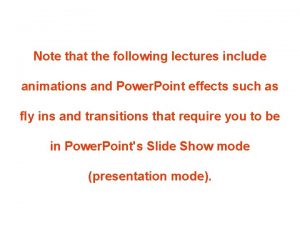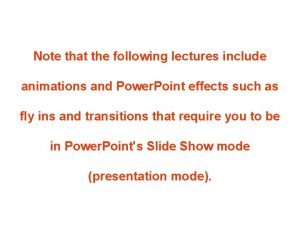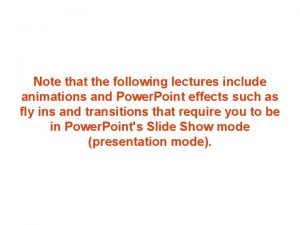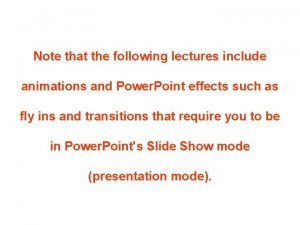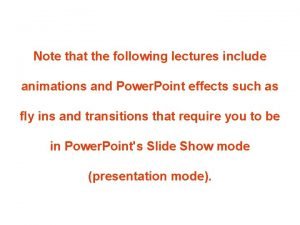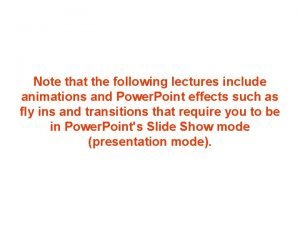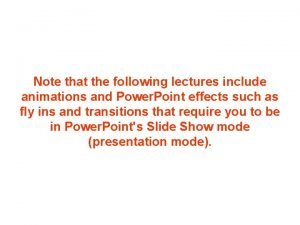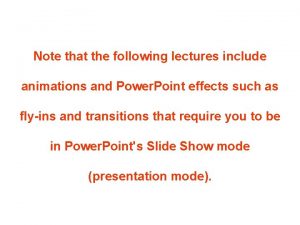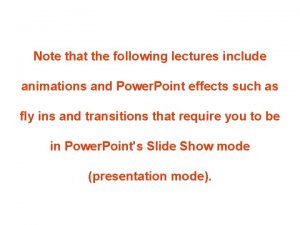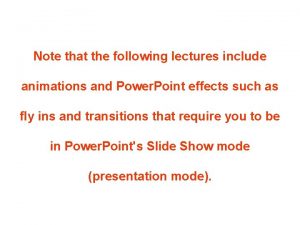Note that the following lectures include animations and




















































- Slides: 52

Note that the following lectures include animations and Power. Point effects such as fly ins and transitions that require you to be in Power. Point's Slide Show mode (presentation mode).

The Origin of the Solar System

Outline I. The Great Chain of Origins A. Early Hypotheses B. A Review of the Origin of Matter C. The Solar Nebula Hypothesis D. Planet-Forming Disks E. Planets Orbiting Other Stars II. A Survey of the Solar System A. Revolution and Rotation B. Two Kinds of Planets C. Space Debris D. The Age of the Solar System

Outline (continued) III. The Story of Planet Building A. The Chemical Composition of the Solar Nebula B. The Condensation of Solids C. The Formation of Planetesimals D. The Growth of Protoplanets E. The Jovian Problem F. Explaining the Characteristics of the Solar System G. Clearing the Nebula

Early Hypotheses • catastrophic hypotheses, e. g. , passing star hypothesis: Catastrophic hypotheses predict: Only few stars should have planets! Star passing the sun closely tore material out of the sun, from which planets could form (no longer considered) • evolutionary hypotheses, e. g. , Laplace’s nebular hypothesis: Evolutionary hypotheses predict: Most stars should have planets! Rings of material separate from the spinning cloud, carrying away angular momentum of the cloud could contract further (forming the sun)

The Solar Nebula Hypothesis Basis of modern theory of planet formation. Planets form at the same time from the same cloud as the star. Planet formation sites observed today as dust disks of T Tauri stars. Sun and our Solar system formed ~ 5 billion years ago.

Extrasolar Planets Modern theory of planet formation is evolutionary Many stars should have planets! planets orbiting around other stars = “Extrasolar planets” Extrasolar planets can not be imaged directly. Detection using same methods as in binary star systems: Look for “wobbling” motion of the star around the common center of mass.

Circumstellar Disk (SLIDESHOW MODE ONLY)

Evidence for Ongoing Planet Formation Many young stars in the Orion Nebula are surrounded by dust disks: Probably sites of planet formation right now!

Dust Disks Around Forming Stars Dust disks around some T Tauri stars can be imaged directly (HST).

Indirect Detection of Extrasolar Planets Observing periodic Doppler shifts of stars with no visible companion: Evidence for the wobbling motion of the star around the common center of mass of a planetary system Over 100 extrasolar planets detected so far.

Survey of the Solar System Relative Sizes of the Planets Assume, we reduce all bodies in the solar system so that the Earth has diameter 0. 3 mm. Sun: ~ size of a small plum. Mercury, Venus, Earth, Mars: ~ size of a grain of salt. Jupiter: ~ size of an apple seed. Saturn: ~ slightly smaller than Jupiter’s “apple seed”. Pluto: ~ Speck of pepper.

Orbits generally inclined by no more than 3. 4 o All planets in almost Exceptions: circular (elliptical) Mercury (7 o) orbits around the Pluto (17. 2 o) sun, in approx. the same plane (ecliptic). Planetary Orbits Sense of rotation: counter-clockwise (with exception of Venus, Uranus, and Pluto) (Distances and times reproduced to scale) nus n tur a S Sense of revolution: counter-clockwise Ura er Ju Earth pit Ma rs Mercury Venus

Two Kinds of Planets of our solar system can be divided into two very different kinds: Terrestrial (earthlike) planets: Mercury, Venus, Earth, Mars Jovian (Jupiter-like) planets: Jupiter, Saturn, Uranus, Neptune

Terrestrial Planets Four inner planets of the solar system Relatively small in size and mass (Earth is the largest and most massive) Rocky surface Surface of Venus can not be seen directly from Earth because of its dense cloud cover.

Craters on Planets’ Surfaces Craters (like on our Moon’s surface) are common throughout the Solar System. Not seen on Jovian planets because they don’t have a solid surface.

The Jovian Planets Much lower average density All have rings (not only Saturn!) Mostly gas; no solid surface

Space Debris In addition to planets, small bodies orbit the sun: Asteroids, comets, meteoroids Asteroid Eros, imaged by the NEAR spacecraft

Comets Icy nucleus, which evaporates and gets blown into space by solar wind pressure. Mostly objects in highly elliptical orbits, occasionally coming close to the sun.

Meteoroids Small (mm – mm sized) dust grains throughout the solar system If they collide with Earth, they evaporate in the atmosphere. Visible as streaks of light: meteors.

The Age of the Solar System Sun and planets should have about the same age. Ages of rocks can be measured through radioactive dating: Measure abundance of a radioactively decaying element to find the time since formation of the rock Dating of rocks on Earth, on the Moon, and meteorites all give ages of ~ 4. 6 billion years.

Radioactive Decay (SLIDESHOW MODE ONLY)

Our Solar System

The Story of Planet Building Planets formed from the same protostellar material as the sun, still found in the Sun’s atmosphere. Rocky planet material formed from clumping together of dust grains in the protostellar cloud. Mass of less than ~ 15 Earth masses: Planets can not grow by gravitational collapse Earthlike planets Mass of more than ~ 15 Earth masses: Planets can grow by gravitationally attracting material from the protostellar cloud Jovian planets (gas giants)

The Condensation of Solids To compare densities of planets, compensate for compression due to the planet’s gravity: Only condensed materials could stick together to form planets Temperature in the protostellar cloud decreased outward. Further out Protostellar cloud cooler metals with lower melting point condensed change of chemical composition throughout solar system

Formation and Growth of Planetesimals Planet formation starts with clumping together of grains of solid matter: Planetesimals (few cm to km in size) collide to form planets. Planetesimal growth through condensation and accretion. Gravitational instabilities may have helped in the growth of planetesimals into protoplanets.

The Growth of Protoplanets Simplest form of planet growth: Unchanged composition of accreted matter over time As rocks melted, heavier elements sink to the center differentiation This also produces a secondary atmosphere outgassing Improvement of this scenario: Gradual change of grain composition due to cooling of nebula and storing of heat from potential energy

The Jovian Problem Two problems for theory of planet formation: 1) Observations of extrasolar planets indicate that Jovian planets are common. 2) Protoplanetary disks tend to be evaporated quickly (typically within ~ 100, 000 years) by the radiation of nearby massive stars. Too short for Jovian planets to grow! Solution: Computer simulations show that Jovian planets can grow by direct gas accretion without forming rocky planetesimals.

Clearing the Nebula Remains of the protostellar nebula were cleared away by: • Radiation pressure of the sun • Sweeping-up of space debris by planets • Solar wind • Ejection by close encounters with planets Surfaces of the Moon and Mercury show evidence for heavy bombardment by asteroids.

New Terms passing star hypothesis evolutionary hypothesis catastrophic hypothesis nebular hypothesis angular momentum problem solar nebula hypothesis extrasolar planets terrestrial planet Jovian planet Galilean satellites asteroid comet meteoroid meteorite half-life gravitational collapse uncompressed density condensation sequence planetesimal condensation accretion protoplanet differentiation outgassing heat of formation radiation pressure heavy bombardment

Discussion Questions 1. In your opinion, should all solar systems have asteroid belts? Should all solar systems show evidence of an age of heavy bombardment? 2. If the solar nebula hypothesis is correct, then there are probably more planets in the universe than stars. Do you agree? Why or why not?

Quiz Questions 1. What was the major problem for the solar nebula hypothesis that was proposed by Pierre-Simon Laplace? a. It did not predict that inner planets orbit the Sun more quickly than outer planets. b. The Sun contains little of the angular momentum of the Solar System. c. It called for a catastrophic event to produce the Solar System. d. The Sun spins more rapidly than is expected. e. All of the above.

Quiz Questions 2. Why do we reject the formation of planets as proposed by Buffon (the passing star hypothesis)? a. Material pulled out of the Sun would be too hot to condense. b. Planetary systems are common, whereas nearby star collisions are rare. c. The angular momentum of the Sun is too low. d. Both a and b above. e. All of the above.

Quiz Questions 3. How do astronomers believe the Sun came to have less angular momentum than its system of planets? a. The solar wind mass outflow carries angular momentum away from the Sun. b. The Sun's magnetic field drags material out in the Solar System, transferring angular momentum outward. c. A large planetesimal impacted the Sun on its leading hemisphere. d. The planets gain angular momentum from passing stars. e. Both a and b above.

Quiz Questions 4. What is the origin of the atoms of hydrogen, oxygen, and sodium in the perspiration that exits your body during an astronomy exam? a. All of these elements were synthesized inside stars more than 4. 6 billion years ago. b. All of the elements were produced in the first few minutes after the Big Bang event. c. The hydrogen nuclei were produced few minutes after the Big Bang event 13. 7 billion years ago, and the oxygen and sodium nuclei were synthesized inside stars more than 4. 6 billion years ago. d. They were all fused deep inside Earth. e. None of the above.

Quiz Questions 5. What evidence do we have that planets form along with other stars? a. At radio wavelengths, we detect cool dust disks around young stars. b. At Infrared wavelengths, we detect large cool dust disks around stars. c. At visible wavelengths, we see disks around the majority of single young stars in the Orion Nebula. d. Both a and b above. e. All of the above.

Quiz Questions 6. How do we know that extrasolar planets are orbiting other stars? a. We see a star's light dim as a planet passes in front of the star. b. We detect alternating Doppler shifts in the spectra of some stars. c. We see a series of small faint points in line with stars, much like Galileo's discovery of the moons of Jupiter. d. Both a and b above. e. All of the above.

Quiz Questions 7. What are the general characteristics of the extrasolar planets discovered so far? a. They have low mass and orbit close to their stars. b. They have low mass and orbit far from their stars. c. They have high mass and orbit close to their stars. d. They have high mass and orbit far from their stars. e. These extrasolar planetary systems are much like the Solar System.

Quiz Questions 8. Why haven't we detected low-mass planets close to their stars and high-mass planets far from their stars? a. Our techniques are not yet sensitive enough. b. We have not been observing for a long enough time. c. We have not been looking at stars similar to our Sun. d. Such systems cannot form, as the material in dust disks is densest close to their stars. e. Both a and b above.

Quiz Questions 9. How is the solar nebula theory supported by the motion of Solar System bodies? a. All of the planets orbit the Sun near the Sun's equatorial plane. b. All of the planets orbit in the same direction that the Sun rotates. c. Six out of seven planets rotate in the same direction as the Sun. d. Most moons orbit their planets in the same direction that the Sun rotates. e. All of the above.

Quiz Questions 10. Which of the following is NOT a property associated with terrestrial planets? a. They are located close to the Sun. b. They are small in size. c. They have low mass. d. They have low density. e. They have few moons.

Quiz Questions 11. How do asteroids and comets differ? a. Asteroids orbit in the opposite direction that the Sun rotates. b. Comets are younger than asteroids. c. Asteroids have lower reflectivity. d. Comets contain ices. e. All of the above.

Quiz Questions 12. Where are most of the asteroids located? a. Inside the orbit of Mercury. b. Between the orbits of Earth and Venus. c. Between the orbits of Earth and Mars. d. Between the orbits of Mars and Jupiter. e. Between the orbits of Jupiter and Neptune.

Quiz Questions 13. Radiometric dating of rock samples indicates that the Solar System formed about 4. 56 billion years ago. Which rock samples have this age? a. Earth rocks. b. Moon rocks. c. Meteorites. d. Both a and b above. e. Both b and c above.

Quiz Questions 14. According to the solar nebula theory, why are Jupiter and Saturn much more massive than Uranus and Neptune? a. Jupiter and Saturn formed earlier and captured nebular gas before it was cleared out. b. Jupiter and Saturn contain more high-density planet building materials. c. Uranus and Neptune have suffered more interstellar wind erosion. d. Both a and b above. e. All of the above.

Quiz Questions 15. How does the solar nebula theory account for the drastic differences between terrestrial and Jovian planets? a. The temperature of the accretion disk was high close to the Sun and low far from the Sun. b. Terrestrial planets formed closer to the Sun, and are thus made of high-density rocky materials. c. Jovian planets are large and have high-mass because they formed where both rocky and icy materials can condense. d. Jovian planets captured nebular gas as they had stronger gravity fields and are located where gases move more slowly. e. All of the above.

Quiz Questions 16. What is the difference between the processes of condensation and accretion? a. Both are processes that collect particles together. b. Condensation is the building of larger particles one atom (or molecule) at a time, whereas accretion is the sticking together of larger particles. c. Accretion is the building of larger particles one atom (or molecule) at a time, whereas condensation is the sticking together of larger particles. d. Both a and b above. e. Both a and c above.

Quiz Questions 17. Which of the following is the most likely major heat source that melted early-formed planetesimals? a. Tidal flexing. b. The impact of accreting bodies. c. The decay of long-lived unstable isotopes. d. The decay of short-lived unstable isotopes. e. The transfer of gravitational energy into thermal energy.

Quiz Questions 18. How does the solar nebula theory explain the formation of an asteroid belt between Mars and Jupiter, rather than a planet at this location? a. A single planet formed here and was disrupted by an impact with a large comet from the outer Solar System. b. Jupiter swept up so much material that not enough was left to form a planet. c. Mars was once larger and collided with a large planetesimal from the inner Solar System that sent debris outward. d. Jupiter formed early, and its gravitational influence altered the orbits of nearby accreting planetesimals such that their collisions became destructive rather than constructive. e. The asteroids were originally moons of the planets that were perturbed by Jupiter's gravity, and now reside in the zone between Mars and Jupiter.

Quiz Questions 19. Which of the following accurately describes the differentiation process? a. High-density materials sink toward the center and lowdensity materials rise toward the surface of a molten body. b. Low-density materials sink toward the center and highdensity materials rise toward the surface of a molten body. c. Only rocky materials can condense close to the Sun, whereas both rocky and icy materials can condense far from the Sun. d. Both rocky and icy materials can condense close to the Sun, whereas only rocky materials can condense far from the Sun. e. Small bodies stick together to form larger bodies.

Quiz Questions 20. How did the solar nebula get cleared of material? a. The radiation pressure of sunlight pushed gas particles outward. b. The intense solar wind of the youthful Sun pushed gas and dust outward. c. The planets swept up gas, dust, and small particles. d. Close gravitational encounters with Jovian planets ejected material outward. e. All of the above.

Answers 1. 2. 3. 4. 5. 6. 7. 8. 9. 10. b d e c e d c e e d 11. 12. 13. 14. 15. 16. 17. 18. 19. 20. d d c a e b d d a e
 #include stdio.h #include stdlib.h #include string.h
#include stdio.h #include stdlib.h #include string.h #include stdio.h #include conio.h #include stdlib.h
#include stdio.h #include conio.h #include stdlib.h #include stdio.h #include stdlib.h int main()
#include stdio.h #include stdlib.h int main() Animasi dalam multimedia
Animasi dalam multimedia Impulse-style scroll animations
Impulse-style scroll animations Pcr animations
Pcr animations Make animation google photos
Make animation google photos Loffe animations
Loffe animations Impact motion tween
Impact motion tween Phân độ lown ngoại tâm thu
Phân độ lown ngoại tâm thu Block xoang nhĩ độ 2 type 1
Block xoang nhĩ độ 2 type 1 Thơ thất ngôn tứ tuyệt đường luật
Thơ thất ngôn tứ tuyệt đường luật Thơ thất ngôn tứ tuyệt đường luật
Thơ thất ngôn tứ tuyệt đường luật Walmart thất bại ở nhật
Walmart thất bại ở nhật Tìm vết của mặt phẳng
Tìm vết của mặt phẳng Hãy nói thật ít để làm được nhiều
Hãy nói thật ít để làm được nhiều Tôn thất thuyết là ai
Tôn thất thuyết là ai Gây tê cơ vuông thắt lưng
Gây tê cơ vuông thắt lưng Sau thất bại ở hồ điển triệt
Sau thất bại ở hồ điển triệt Difference between note making and note taking
Difference between note making and note taking Signal words for cause and effect
Signal words for cause and effect Difference between note making and note taking
Difference between note making and note taking Draw a specimen of debit note
Draw a specimen of debit note Nota debit adalah
Nota debit adalah Note taking and note making
Note taking and note making Goods received note
Goods received note Loan x has a principal of $10 000x
Loan x has a principal of $10 000x #include iostream #include string
#include iostream #include string Include stdio.h
Include stdio.h Include iostream using namespace std
Include iostream using namespace std #include iostream #include cmath
#include iostream #include cmath #include stdio.h int main()
#include stdio.h int main() #include
#include  Cppinclude
Cppinclude Include namespace std
Include namespace std Utilities and energy lecture
Utilities and energy lecture Theory and practice of translation lectures
Theory and practice of translation lectures Molecular biology lectures
Molecular biology lectures Rick trebino
Rick trebino Lectures paediatrics
Lectures paediatrics Data mining lectures
Data mining lectures Medicinal chemistry lectures
Medicinal chemistry lectures Uva powerpoint
Uva powerpoint Ludic space
Ludic space Step wise project planning
Step wise project planning Radio astronomy lectures
Radio astronomy lectures Dr sohail lectures
Dr sohail lectures Introduction to web engineering
Introduction to web engineering
